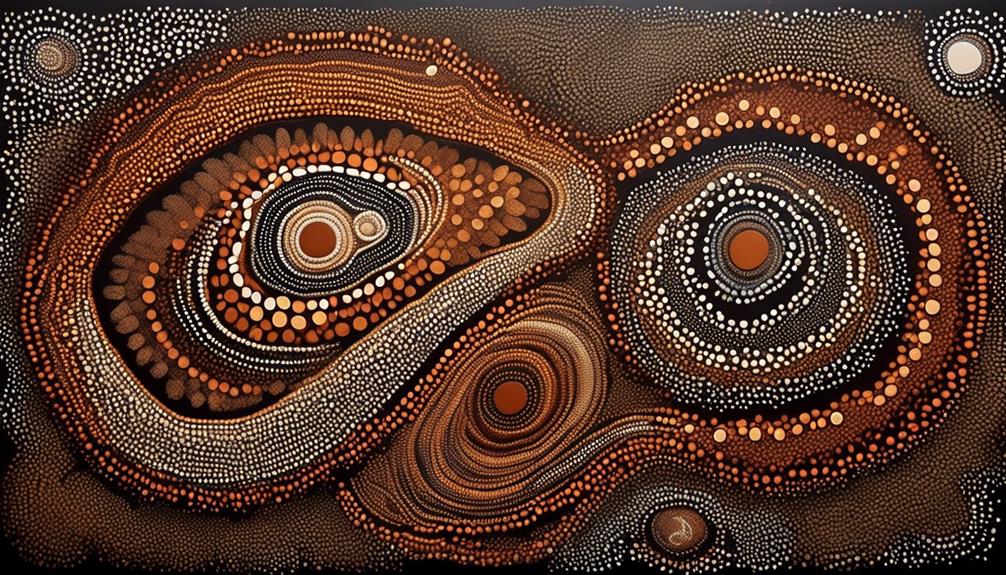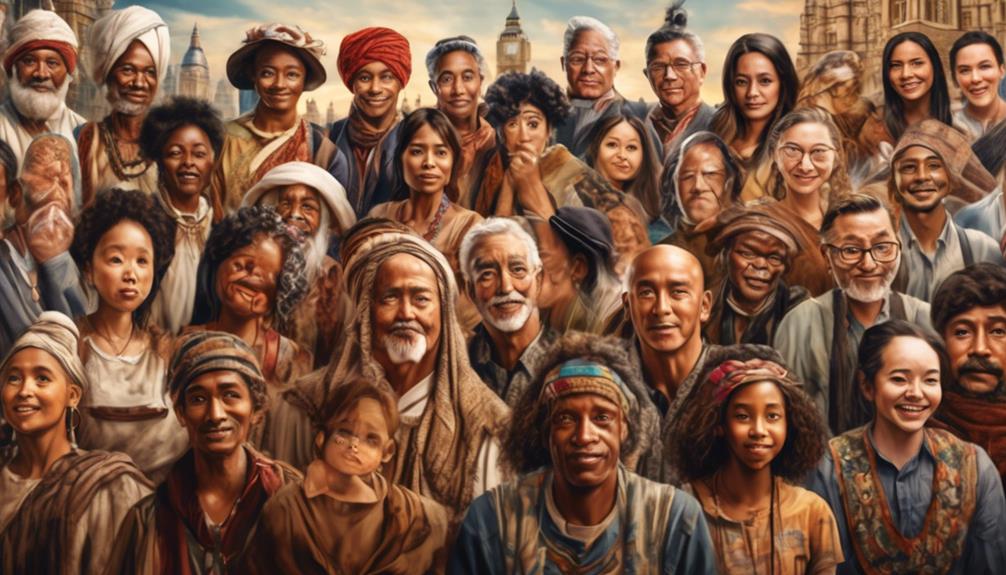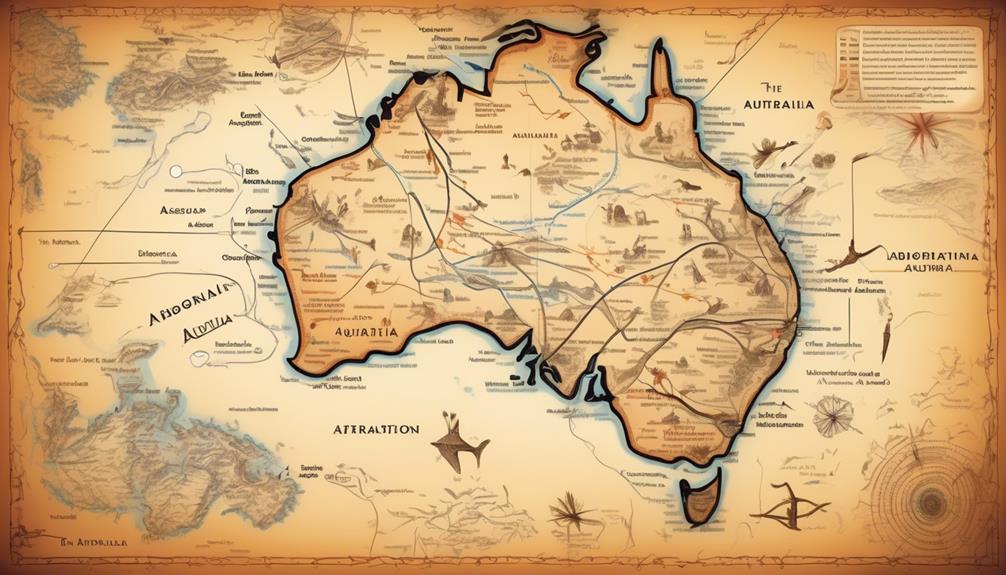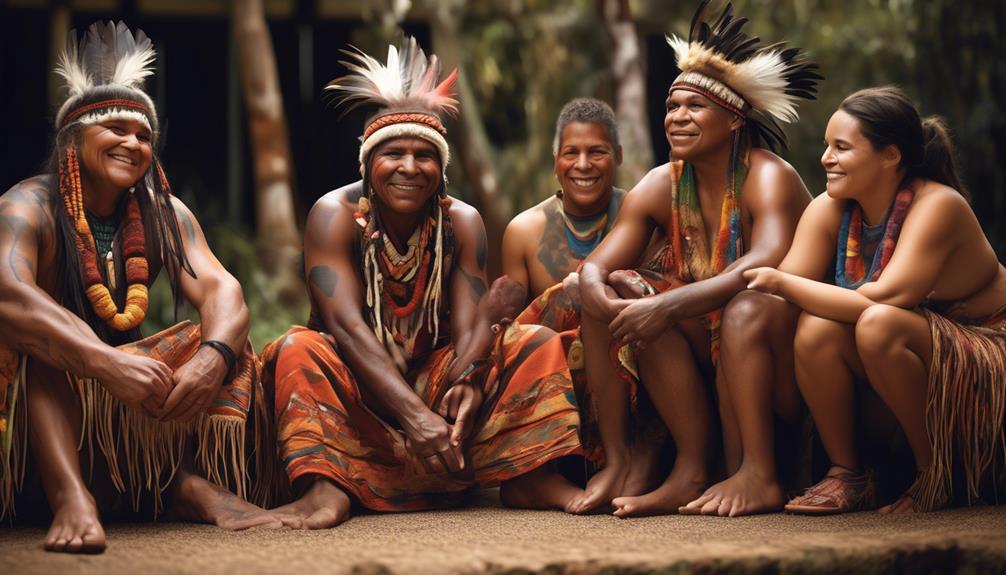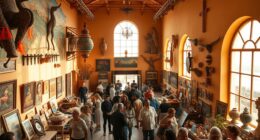Imagine yourself standing in front of a magnificent and intricate tapestry, woven with threads of history, culture, and artistry.
Aboriginal canvas art is akin to this tapestry, each piece telling a story of rich tradition and heritage.
From the Dreamtime narratives to the contemporary reimagining of ancient symbols, the evolution of Aboriginal canvas art is a journey that spans generations and landscapes.
As you explore the origins and symbolism embedded in these artworks, you'll uncover a world of profound significance and creativity that continues to captivate and inspire.
Key Takeaways
- Aboriginal canvas art originated from the cultural traditions and spiritual beliefs of indigenous peoples in Australia.
- Each symbol, dot, or line in the artwork carries profound meaning, often representing elements of the Dreamtime.
- Traditional techniques in Aboriginal canvas art include dot painting, cross-hatching, and rarrk techniques.
- Aboriginal canvas art has evolved in contemporary art, blending traditional storytelling with modern influences.
Origins of Aboriginal Canvas Art
The origins of Aboriginal canvas art can be traced back to the rich cultural traditions and spiritual beliefs of the indigenous peoples of Australia. Traditional techniques, passed down through generations, hold deep cultural significance for the Aboriginal people.
The art forms weren't just decorative; they were a means of storytelling, expressing connections to the land, and conveying spiritual beliefs. The traditional methods of creating Aboriginal canvas art involved using natural materials such as bark, ochre, and feathers. These materials were meticulously prepared and applied using techniques that have been refined over centuries.
Each symbol, dot, or line in the artwork carries profound meaning, often representing elements of the Dreamtime, the ancestral period when the world was created. The intricate patterns and designs aren't only visually striking but also hold layers of cultural significance, reflecting the interconnectedness of the Aboriginal peoples with their land and spirituality.
Today, contemporary Aboriginal artists continue to honor these traditional techniques while also incorporating modern materials and styles, ensuring that the cultural heritage remains vibrant and relevant in the contemporary art world.
Symbolism and Storytelling in Aboriginal Canvas
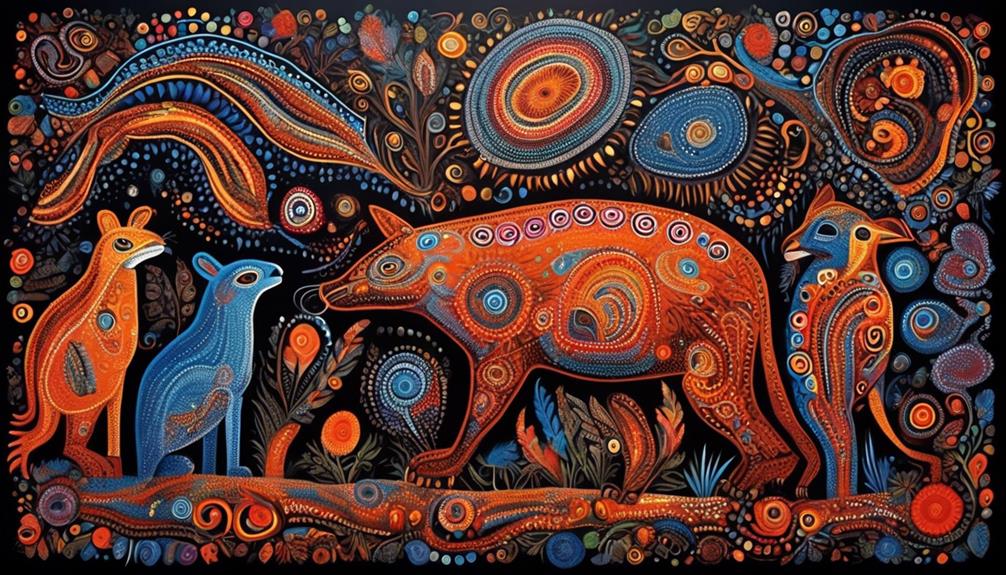
Symbolism and storytelling in Aboriginal canvas art convey profound cultural and spiritual significance through intricate patterns and designs. The use of symbols in Aboriginal art serves as a visual language, communicating stories of creation, ancestral knowledge, and the natural world. This art form holds deep cultural significance, preserving and passing down traditions from generation to generation.
- Dreamtime Stories: Aboriginal canvas art often depicts Dreamtime stories, which are the foundation of Aboriginal culture. These stories explain the creation of the world and the spiritual beliefs of the Aboriginal people.
- Connection to Country: The symbols and storytelling in Aboriginal canvas art are deeply connected to the land, expressing the Aboriginal people's spiritual and cultural relationship with their ancestral territories.
- Ceremonial Significance: Many symbols used in Aboriginal canvas art represent ceremonial practices and rituals, conveying the spiritual connection between the artist, their community, and the ancestors.
The intricate designs and symbols found in Aboriginal canvas art carry rich layers of meaning, serving as a visual representation of the profound cultural and spiritual significance within Aboriginal communities.
Techniques and Materials Used in Aboriginal Canvas
Exploring the techniques and materials used in Aboriginal canvas art uncovers the intricate craftsmanship and cultural significance embedded within each creation. Traditional techniques are deeply rooted in Aboriginal culture, often involving intricate dot painting, cross-hatching, and rarrk techniques. These methods are passed down through generations, representing a strong connection to cultural heritage and ancestral stories.
Natural materials such as ochre, charcoal, and natural pigments are commonly used in Aboriginal art, each holding symbolic meanings within the artwork.
In contemporary interpretations, Aboriginal artists have embraced new materials and techniques while still preserving the traditional essence of their art. They often use acrylic paints on canvas, allowing for a wider array of colors and textures. Despite these modern adaptations, the cultural significance remains at the core of every artwork. The connection to the land, ancestral stories, and spiritual beliefs continues to be deeply woven into the fabric of each piece.
Understanding the techniques and materials used in Aboriginal canvas art provides insight into the depth of cultural significance and the ongoing evolution of this ancient art form.
Evolution of Aboriginal Canvas in Contemporary Art
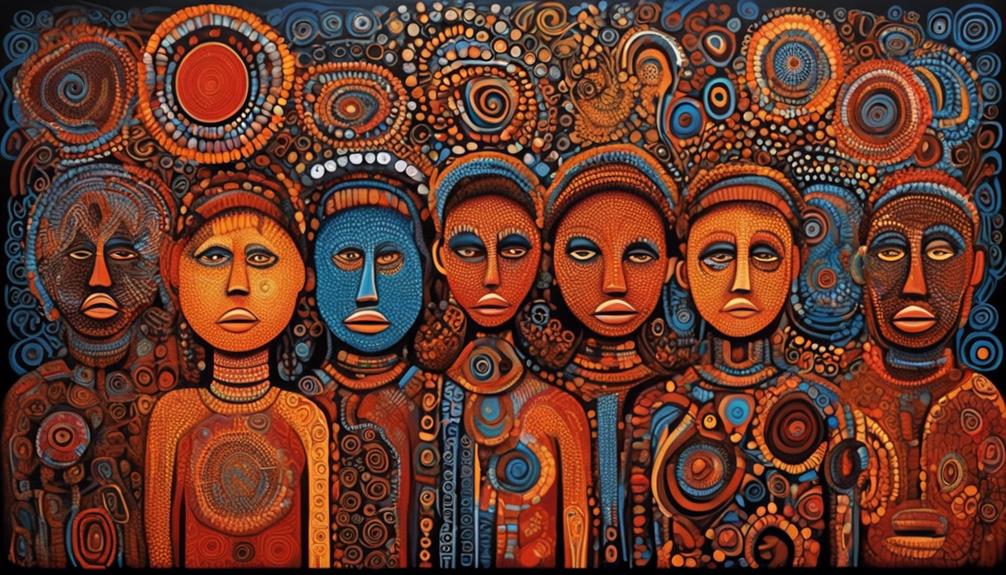
Amidst the ever-changing landscape of contemporary art, Aboriginal canvas art has undergone a profound evolution, embracing new forms of expression while retaining its cultural roots. The evolution of Aboriginal canvas in contemporary art is a testament to the resilience and adaptability of Indigenous artistic traditions.
Here are key aspects to consider:
- Contemporary Interpretations: Aboriginal artists are infusing traditional storytelling with modern influences, exploring themes such as urban life, environmental issues, and personal experiences. This blending of traditional and contemporary elements creates a dynamic and multi-layered visual narrative that resonates with audiences globally.
- Cultural Preservation: While embracing contemporary techniques and styles, Aboriginal artists continue to uphold the cultural significance of their art. The evolution of Aboriginal canvas in contemporary art serves as a means of preserving and promoting Indigenous cultural heritage, ensuring that ancient stories and traditions remain relevant and accessible in the modern world.
- Global Impact: The evolution of Aboriginal canvas in contemporary art has garnered international attention, leading to increased visibility and recognition for Indigenous artists. Through exhibitions, collaborations, and digital platforms, Aboriginal artists are sharing their unique perspectives and enriching the global art landscape with their rich cultural heritage.
Influential Aboriginal Canvas Artists
Several influential Aboriginal canvas artists have redefined contemporary art with their unique perspectives and cultural narratives. Their works not only showcase the richness of Aboriginal culture but also reflect contemporary influences, making a significant impact on the art world. Here are some of the most influential Aboriginal canvas artists whose works have contributed to the cultural significance of contemporary art:
| Artist | Cultural Background | Notable Works |
|---|---|---|
| Emily Kame Kngwarreye | Anmatyerre | "Big Yam Dreaming", "Alalgura" |
| Clifford Possum Tjapaltjarri | Warlpiri | "Warlugulong", "Man's Love Story" |
| Sally Gabori | Kaiadilt | "Dibirdibi Country", "Yinalpi" |
| Lin Onus | Yorta Yorta | "Fruit Bats", "Urban Dingo" |
These artists have skillfully merged traditional storytelling with contemporary art forms, offering a fresh perspective to the art world. Their works not only represent their cultural heritage but also serve as a bridge between the past and present, enriching the art landscape with diverse narratives and expressions.
Frequently Asked Questions
Can Non-Indigenous Artists Create Aboriginal Canvas Art?
Yes, non-indigenous artists can create aboriginal canvas art. However, it's essential to be mindful of cultural appropriation and to approach the artistic expression with respect and understanding of the cultural significance.
It's crucial to engage in meaningful dialogue, seek permission, and collaborate with indigenous communities. By doing so, you can create art that's both respectful and inclusive of indigenous perspectives while honoring the traditional practices and stories.
Are There Specific Rules or Guidelines for Creating Aboriginal Canvas Art?
When creating art, it's important to be mindful of cultural appropriation and to follow specific guidelines for respectful representation.
This applies to any cultural art form, including aboriginal canvas art. It's crucial to understand the cultural significance and symbolism behind the art, and to ensure that your work is created with respect and authenticity.
What Role Do Traditional Aboriginal Elders Play in the Creation of Contemporary Aboriginal Canvas Art?
Traditional knowledge is vital in the creation of contemporary aboriginal canvas art. Elders play a crucial role in preserving cultural heritage and passing down artistic traditions. They provide guidance and insight into the cultural significance of symbols and motifs, while also encouraging artistic innovation and contemporary expression.
Their influence ensures that the art remains rooted in tradition while also evolving to reflect the changing world.
How Do Aboriginal Artists Incorporate Modern Themes and Issues Into Their Canvas Art While Still Honoring Traditional Storytelling and Symbolism?
When incorporating modern themes and issues into canvas art, Aboriginal artists skillfully blend modern interpretations with indigenous symbolism. They navigate the delicate balance of honoring traditional storytelling and symbolism while addressing contemporary concerns.
This requires a deep understanding of artistic boundaries and a respectful approach to avoiding cultural appropriation. By doing so, they create powerful artworks that bridge the past and the present, offering profound insights into the complexities of Indigenous culture and identity.
Are There Specific Regional Differences in the Style and Techniques Used in Aboriginal Canvas Art?
Regional differences in aboriginal canvas art are significant, with diverse artistic influences shaping styles and techniques.
Each region's unique cultural heritage and environmental surroundings contribute to these distinctions.
For instance, the desert regions often showcase intricate dot paintings, while coastal areas may feature more fluid and organic designs.
Understanding these regional distinctions provides valuable insight into the rich tapestry of aboriginal art and the stories it conveys.
Conclusion
In conclusion, Aboriginal canvas art beautifully blends tradition and innovation, using symbolism and storytelling to share cultural heritage.
The techniques and materials used in this art form have evolved, creating a captivating contemporary expression.
Influential Aboriginal canvas artists continue to inspire with their creative contributions.
The allure of Aboriginal canvas art lies in its ability to capture the essence of culture, conveying compelling narratives and connecting communities.
